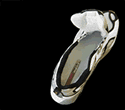|
|
|
|
|
|
In order for a shoe to support the foot it must have a rigid mid-sole
that resists torque. A soft spongy mid-sole, like the one below
won't help reduce over pronation
so it can't offer the foot much support.
|
|
|
Check your shoe! Grab the shoe by the ball of the foot and the heel
and twist it as if you were trying to wring water out of it. If
it twists up, like in the example above, then no matter what other
support elements it may have the shoe probably isn't going to give
your feet much support. If you are experiencing or commonly experience
foot, ankle or knee problems then you should consider trying a shoe
with a more rigid mid sole.
|
|
|
 |
Look
under the insole to get a better idea of how a shoe will perform.
To do this you must first remove the insole. Most quality athletic
and casual shoes have removable insoles that pull right out.
If the insole is glued in place then don't force it out, just
see if you can peel a little of the side edge back enough to
take a peek at what is underneath. |
|
|
|
| One of the
most fundamental and effective methods of firming up a mid-sole and
adding support to a shoe is to use a Texon cardboard shoe liner. Texon
cardboard is a cross between regular cardboard and particle pressboard.
Even thin sheets of Texon are light, tough and very firm. Almost every
shoe company uses Texon but not in every shoe they make. |
|
|
|
|
|
This
shoe has a 3/4 length, yellowish Texon cardboard liner.
|
|
If
you can see the stitching on the bottom of the shoe then it
has no liner.
|
|
| To see if
a shoe uses a Texon cardboard liner first remove the insole then look
inside at the bottom of the shoe. If the shoe uses Texon, you will
see a pinkish to yellowish colored Texon board glued to the bottom
of the shoe. In most shoes, either athletic or casual the board liner
runs 3/4 of the length of the shoe, usually from the heel to the ball
of the foot. In outdoor shoes and hiking boots it is not uncommon
to see the Texon board liner run the full length of the shoe. |
|
|
| One thing that
happens to shoes as they accumulate mileage is that the mid-sole breaks
down and loses rigidity. This translates into a loss of support and
an increase in the likely hood of discomfort and/or injury. Even shoes
with dense, hard mid-soles and Texon board liners will eventually
break down. In the end all shoes wind up flexible (and twistable)
like the one in the picture at the top
of the page. Check your shoes from time to time to see how much
support is left. Replace shoes when you can twist them with both hands.
This is a very reliable method for checking the amount of wear and
tear on a shoe. Remember that shoes only wear out if they are used.
Shoes that sit in the closet for years generally maintain their support.
|
|
|
|
